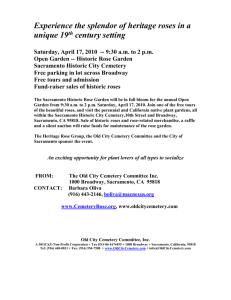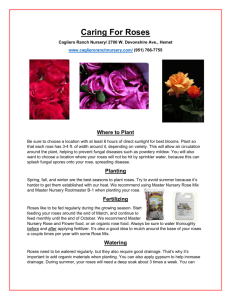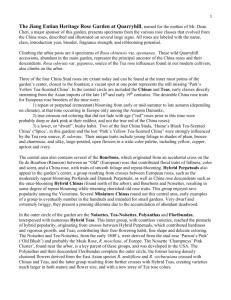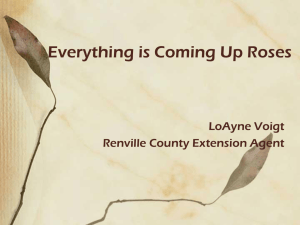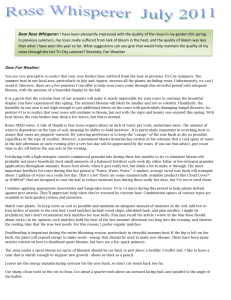The OGR Shrub The OGR Shrub
advertisement
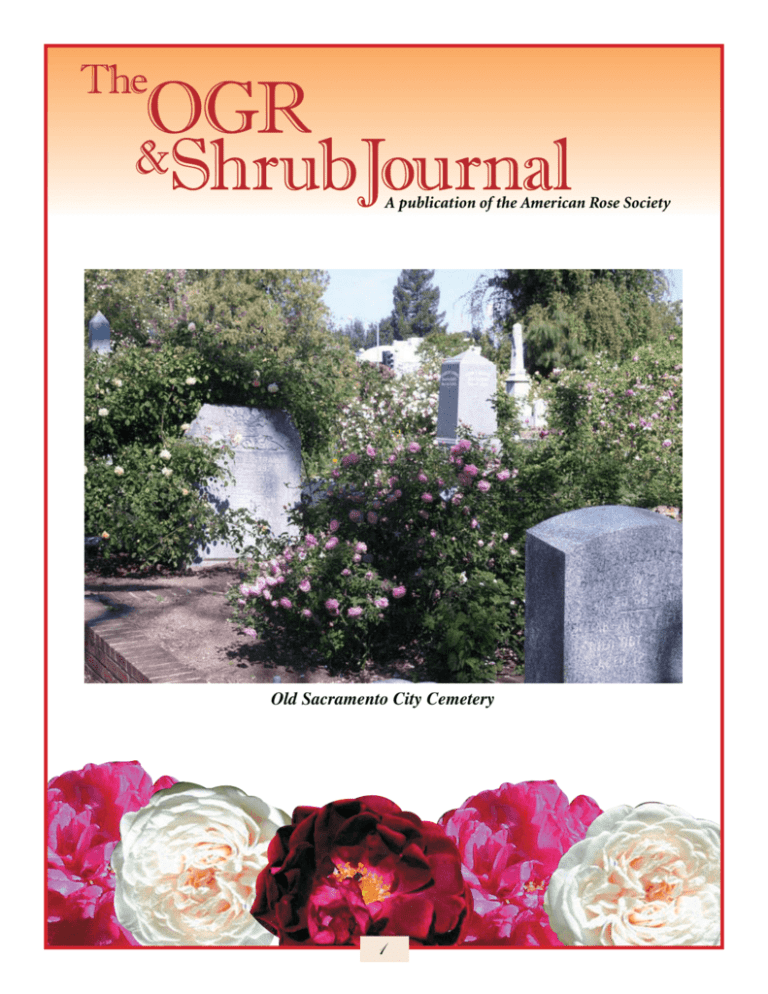
A publication of the American Rose Society Old Sacramento City Cemetery 1 The Garden A Gold Rush Created The Story Of An Historic Rose Garden: The Old Sacramento City Cemetery By Jeri Jennings “Suddenly, all my misgivings were put to an end by his [Marshall] flinging on the table a handful of scales of pure virgin gold. I was fairly thunderstruck and asked him to explain what all this meant” Johann Augustus Sutter Forest Ranch Pom-Pom A Damask Perpetual in the Sacramento Cemetery Garden 2 to a new concept in cemeteries. The “Rural” or “Garden” Cemetery, combined classical monuments and gardens in a lovely terrain, making it as much a park as a burial ground. Sacramentans, of course, wanted something just as beautiful as Mount Auburn. They had the means to achieve it, and (as is usual for Californians) they took this ideal of a “Garden” Cemetery and remade it into a thing uniquely Californian in content and expression. Poor Sutter! Many dreams were born with the discovery of gold in his Sierra foothills millrace, but Sutter’s own dreams died there. The little rural kingdom that energetic, enigmatic Swiss immigrant had created on the banks of the Sacramento River was washed away in a flood of gold-fever-inspired immigration. As 1848 began, California had a population of some 34,000 souls – principally Californios of Mexican descent and American Indians, with a scattering of Yankee and other adventurers. Between 1848 and 1854, everything changed. At the news of gold in California, some 300,000 adventurers flooded into California from every corner of the Earth. They brought their languages, and customs, their religions, and recipes – and their garden plants. Their arrival forever altered the future and character of the place that would become the State of California. By February, 1850, Sutter’s once-quiet rural settlement had swollen to a population of 6000. Sacramento had become the first incorporated city in California. By that fall, the infant city had experienced the first of a series of devastating floods, and had suffered through its first great epidemic. Cholera came to Sacramento, and even the doctors died. ‘Burbank’ Tea Burbank 1900 Sacramento’s Historic City Cemetery opened in 1850, on ten acres of donated land. The new Cemetery was sited on a sandy hill – the highest ground in that low-lying area – well above the reach of flood waters. Neatly-outlined family plots were individually numbered, owned, and maintained, and Sacramento’s prosperous families vied to make theirs the loveliest and best garden plots. Broad carriageways, shade trees, and a pleasant breeze invited visitors to linger among the gardens. Far too soon, Sacramento needed a burial ground. The “Garden Cemetery” In 1831, Mount Auburn Cemetery in Massachusetts had introduced America 3 Roses, of course, figured prominently in the mix of plants – and there were plenty of roses to choose from. Concerned Sacramentans addressed the problem vigorously. With the approval of the City, a volunteer “Old City Cemetery Committee” was formed. Two decades later, this Committee continues its work, under the mission statement: Between 1850 and 1900, some four thousand different cultivars of roses were imported into California, and offered for sale by several local nurseries. The finest of newlyintroduced French roses quickly found their way to San Francisco and Sacramento. From there, making their way onward to Mexican Land Grant ranches and rough Gold Mining towns, they filled gardens and rural cemeteries with surprisingly exotic beauty. “To join hands with the community to restore, beautify, preserve and protect the Historic City Cemetery, while maintaining access by descendants of the deceased, and to provide educational services to all visitors to the Historic City Cemetery of Sacramento.” Volunteers stepped forward. An AdoptA-Pioneer Plot program was instituted to foster repair and re-planting in the old Cemetery plots. In 1988, Sacramento Mayor Anne Rudin planted heavenly bamboo, iris, lamb’s ear, and two ‘Perle d’Or’ roses on the family plot of former Mayor (1863-1871) C.H. Swift. When the exuberance of the Gold Rush began to fade, gold-seekers moved on. Their roses and gardens were left behind in the dwindling mining camps, forgotten – and preserved by solitude. Over the years, Adopt-A-Plot has involved hundreds of volunteers, caring for hundreds of plots – an idea which led to the planting of new gardens in the old cemetery. And Then There Were Roses With activity in the cemetery stepping up, Botanist and Rosarian Fred Boutin, along with Jean Travis of the Perennial Plant Club, took a “rose survey” of the cemetery. They found about 20 surviving historic roses. Exploring the cemetery, Boutin thought it could be the ideal site for a collection of historic roses. The City of Sacramento set aside nearly three acres within the Cemetery for that purpose, and in March, 1992, Perennial Plant Club volunteers planted 100 roses, including clones of the cemetery’s surviving roses. The Historic Rose Garden of the Sacramento Historic City Cemetery was born. ‘Lady Waterlow’ Cl HT Nabonnand 1903 Over the years, Sacramento families died out or left the area, leaving no one to maintain their plots. By the 1950’s, the City Cemetery was ageing – and showing the effects of long neglect. By the 1980’s, its condition was dire. Many plots were weed-grown, and covered with trash. Transients camped under the old trees, and vandalism was a problem. Clearly, action was needed. 4 ‘Reve d’Or’ Noisette Ducher 1869 section of the history of roses – in particular, roses in the Golden State. The collection remains easily accessible to rosarians, rose scholars, romantics, and lovers of gardens. Boutin contributed, from his personal collection, roses collected in old towns and cemeteries throughout the Gold Rush country – living links to the Gold Rush era, and Sacramento’s beginning. Clones of these tough old roses thrive here, in company with roses contributed by Jean Travis, Carl Luhn, Muriel Humenick, and others. Over time, other groups and individuals have donated roses, and the garden continues to grow – now numbering approximately five-hundred roses. They grow in company with other perennial and native plants, in an increasingly balanced ecology. Though still based on California’s wonderful “found” roses, the collection now includes species and other roses known to have been grown or sold in California from 1850 to 1915 As Boutin foresaw, the design of the old cemetery, with its numbered plots, facilitated organization of the collection for study, maintenance, preservation, propagation – and beauty. As it has grown and matured, the Historic Rose Garden has become a wonderful cross- 5 – the Cemetery’s period of significance. The roses, for the most part, are allowed to reach their genetically-patterned size and habit, creating a garden whose beauty is increased by its unique style. As old plants are removed from other pioneer cemeteries, or lost to age and drought, and once-quiet small towns are “redeveloped,” this collection, in this beautiful place, has become an increasingly important place of refuge for old and rare roses. these areas were planted, and are maintained, by volunteers. Today, as it has been from the start, the Historic Rose Garden is maintained by a tightly-knit group of volunteers. Barbara Oliva came to help plant the garden in 1992. She stayed, eventually becoming Curator of the Collection, and guiding its development.1 Anita Clevenger serves as Garden Manager. Judy Eitzen edits a Garden Newsletter, and maintains the garden’s lovely website. Volunteers groom roses, collect roses, propagate roses, and conduct educational workshops and tours. New Orleans Cemetery Rose Discovered by Maureen Detweiler in an old New Orleans cemetery As its 19th-Century founders intended, the Historic Old City Cemetery remains a place of peace and beauty in the center of a bustling city. The Rose Garden has become, as well, a place of study, and a source from which more than a few cultivars have been re-introduced into commerce. In a time when the numbers of rose vendors, as well as gardens, are shrinking, the “garden-as-refuge” becomes increasingly more important. Barbara Olive, with Chester In Spring, 2009, Great Rosarians Of The World2 recognized this remarkable volunteer program, and the excellence of the Garden – honoring the Historic Rose Garden with its annual G.R.O.W. Award for Gardens. It is fitting that the Historic Rose Garden and the San Jose Heritage Rose Garden3 were the first two recipients of this award. The two gardens, located just 115 miles apart, Other gardens followed the success of the Historic Rose Garden. A Perennial Garden, on the Southwest side of the Cemetery, is balanced by a garden of California native plants, on the southeast side. Like the Historic Rose Garden, 6 of color and bounty of bloom that makes Autumn days here glorious. In winter, the garden is cool and quiet, with a more restrained color palette. Summer is a time of vivid sun, rich fragrance, and deep shade. Still, the garden’s most spectacular season, and its greatest party happens in mid-April. have a strong history of close, mutuallybeneficial cooperation. Spring is the time of greatest glory for most rose gardens, but this garden is beautiful in any season. Among its roses of all types, the Tea, China, and Noisette roses – well-suited to California’s Mediterranean climate – provide a depth ‘Buff Beauty’ Bentall 1939 More than 500 people attended the 2009 Open Garden – some from across the continent.) The event succeeds on multiple levels – offering beauty, friendship, pleasure, education, and preservation of unique cultivars through widening distribution. Every April, when the garden’s onceblooming roses are at their height, and the “Evergreen” roses explode with color, cemetery volunteers hold an Open Garden and Rose Sale. The event, which includes a sale of plants propagated from the garden, draws a greater following every year. To learn more about the Historic Rose Garden, and view more photographs, visit the website, http://www.cemeteryrose.org/ 7 ‘Maman Cochet’ Tea Cochet 1893 R, eglanteria in winter 8 Vina Banksia A probable Banksia hybrid found on historic ranch land Many thanks to Anita Clevenger, for keeping my facts on the straight and narrow -- Jeri Jennings heritageroses@gmail.com 1 Join Barbara Oliva in the garden. Visit: http://www.oldcitycemetery.com/Bee0397.htm 2 Great Rosarians Of The World is an international group of prestigious rosarians. See: http://www.greatrosarians.com/ 3 San Jose Heritage Rose Garden, Guadalupe Gardens, San Jose, California. Pulich Children Probable Hybrid Perpetual Found and propagated by Janelle Michel and Kathryn McKenzie All photos courtesy of Jeri Jennings 9 John Clements: Rosarian By Louise Clements John Clements was born in South San Francisco in 1936. He joined the Air Force at 19 and spent four years in England as an air-traffic controller. He continued in this work with the FAA after he returned to civilian life until his retirement in 1984. The stress that this work is noted for affected his health, and he had a record of heart trouble; this finally proved fatal on August 8, 2007. our marriage in 1979 we moved to the Willamette Valley in 1982; in 1985 we John began his rose life at Small World Miniature Roses nursery Medford, Oregon in 1972. During this time he began hybridizing minis, but was content to sell the roses created by others. After Included in the catalogue were thirteen of John’s minis: ‘Antique Tapestry’, ‘Britestripe’, ‘Color Purple’, ‘Fancy Lady’, ‘Firestorm’, ‘Golden Intensity’, ‘Gold Strike’, ‘Golden Girls’, ‘Honey Mini-delite’, ‘Oregon Rainbow’, ‘Peach bought five acres in St. Paul, Oregon, some 20 miles southwest of Portland. Heirloom Old Garden Roses produced its first catalogue in 1989, at which time Small World Miniatures was absorbed into Heirloom, although a separate website was maintained for it. 10 Silks’, ‘Royal Harlequin’, and ‘Sweet Shirley’. Of these, only one miniature, ‘Fancy Lady’, remains in our catalogue today. In 1991, John’s first hybridizing efforts continued with the introduction of two Hybrid Chinas, ‘Dragon’s Eye’ and ‘Shanghai Princess’. After this initial burst, his interest in the hybridization of OGRs and Minis waned, to be replaced by an interest in breeding shrub roses. Between 1995 and 2000 we introduced four Hybrid Musks, two Hybrid Multifloras, and five Hybrid Wichuranas. Only two from this group, the Hybrid Wichuranas ‘Soaring Flight’ and ‘The King’s Rubies’, plus a later introduction, ‘Dreaming’ from 2006, remain in our 2009 offerings. ‘Fancy Lady’ Perhaps the defining moment in John’s rose life came in 1987 with a visit to England and the gardens of David Austin. He stood in the midst of that garden of Austin’s English Roses and Old Garden Roses and declared “This is the way the United States is going to go and this is what we are going to do!” From this time on John imported a prodigious number of roses from overseas, both for propagation and sale and later for use in his own breeding program. ‘Dreaming’ The mid-1990’s also saw the introduction of the first of John’s roses to be designated simply as shrubs. Our very first introduction of John’s in this category was ‘Ruffles ‘n’ Flourishes’, a very low-growing red blend variety introduced in 1994 and bred from ‘Sexy Rexy’ x ‘Whistle Stop’, both roses from Sam McGredy. ‘Ruffles ‘n’ Flourishes’ is one of very few of John’s roses for which he provided parentage. Although he did keep a record of his crosses, he seldom passed this on, even to us here at Heirloom, when he selected and registered his seedlings. This practice is reflected by his comment that he made in an article from 1995: He realized well before the rest of the U.S. rose industry that “Austinesque” roses were the wave of the future – hardy, disease resistant, and fragrant shrub roses of various sizes and with a variety of bloom types. He was also the first to respond to the request from the rose loving public to provide virus-free, own-root roses. His many years of growing miniatures on their own roots convinced him that growing the larger roses that were free of virus and on their own roots would be the answer. 11 For years I have read all the books in rose breeding that I could get my hands on. I have visited some of the world’s top rose breeders here, in England, and in Europe, armed with many questions. Every rose breeder seems to have a few secrets locked away but almost to a man they were very helpful and informative. I feel now, after fifteen years, that we are making good and exciting progress in developing new and unique varieties. I have many ideas for the type of roses I want to breed, and what parents to use....but I’ll keep that my secret. ‘The Impressionist’ (‘Graham Thomas’ x ‘Distant Drums’) ‘Louise Clements’ (‘Graham Thomas’ x ?) ‘Morning Has Broken’ (‘Graham Thomas’ x ‘Gold Badge’) ‘Good Ol’ Summertime’ (‘Sexy Rexy’ x ‘Hero’) ‘Star of the Nile’ (seedling #22397 x ‘The Yeoman’) ‘Portlandia’ (seedling #22397 x ‘Golden Celebration’) ‘Braveheart’ (‘Tamango’ x ‘The Dark Lady’) ‘Fragrant Masterpiece’ (‘Mary Rose’ x ‘Golden Masterpiece’) Nonetheless, John’s breeding records do indicate a preference for certain parents. For seed parents, the varieties ‘Sexy Rexy’, ‘Amber Queen’, ‘Graham Thomas’, ‘Angel Face’, ‘Perdita’, and one of his own unnamed seedlings appear most often, while for pollen parents ‘The Yeoman’, ‘Golden Celebration’, ‘Perdita’, ‘Distant Drums’, ‘Gold Bade’, ‘Jude the Obscure’, ‘Trier’, and his own ‘Morning Has Broken’ occur repeatedly. Many of these parents are evident in a short list of our most commercially successful of John’s varieties, which are, in descending order of sales: ‘Morning Has Broken’ The year 1996 proved to be a good one for John’s roses, as four that were introduced that year are still in our catalogue: ‘Morning Has Broken’, (CLEwedding), (‘Graham Thomas’ x ‘Gold Badge’), named after the Cat Stevens song played at our wedding; ‘Joan Fontaine’, with heavily-petalled, creamy white blooms and a 7.8 ARS rating; ‘Kateryna’, a soft pink named for our granddaughter, and; ‘Louise Clements’, with blooms of an intense copper-orange and named for me. ‘Portlandia’ 12 All of the above varieties are moderateto-low-growing plants which could well be considered floribundas rather than shrubs. However, I think that their Austinesque bloom habit and flower form led John to emulate David Austin and register them as shrubs. One of John’s introductions ‘Morning Has Broken’ has proven to be one of the most disease resistant roses in existence and has been grown in nearly every part of the United States with superb results. was the first nursery in North American to introduce the Harkness “Floorshow” collection of low-growing ground covers. Like some other hybridizers, most notably Sam McGredy and Jack Harkness, John named a number of his roses after beloved members of his family. This list includes: ‘Louise Clements’ mentioned above ‘Kateryna’ also mentioned above ‘Ruth Clements’ a medium sized shrub with heavily-petalled blooms of coral and pink. Introduced in 2000 and named for John’s mother. ‘Lexy’ soft pink blooms forming in sprays of 12-15 florets on a tall shrub to 6 ft. Named for our granddaughter Alexandra and introduced in 2000. ‘Louise Clements’ John’s admiration for the work of David Austin has led us to stock a number of his English Roses over the years. At present we offer over 80 varieties, more than any other American Nursery except for David Austin Roses themselves, and including a few that even Austin himself does not market in the U.S. While we have carried, and continue to carry, roses from wide variety of hybridizers around the world and here in the U.S., probably the largest number from a single hybridizer or nursery are the English Legend series from Harkness Roses in the U.K. The series consists of over 50 varieties, and includes some that have been previously introduced in the U.S., such as ‘Livin’ Easy’ and ‘Margaret Merril’, plus a large number that have not. It includes everything from climbers to hybrid teas, and Heirloom ‘Lexy’ ‘Laura’ named for, and selected by, our daughter, this low-growing plant has blooms of apricot, cream, and pink. Introduced in 2002. ‘Anna Louise’ perhaps its code name of CLEcanteloupe best describes the orange-copper color of the blooms on this medium-sized shrub. Introduced just this year, ‘Anna Louise’ was named for our John’s youngest step- 13 granddaughter, and was the last rose that he personally named. blooms), newsman Charles Kuralt (with low-petalled coral-pink blooms with a nice fragrance). At John’s invitation British nurseryman and hybridizer Peter Beales personally selected the rose from our garden that is named for him. (having single red blooms with a yellow eye and a strong aroma). All in all, John hybridized over 70 rose varieties classed simply as shrubs, in addition to the aforementioned “classic” shrubs and a few Large Flowered Climbers. He stated his hybridizing philosophy thus: ‘Anna Louise’ ‘Brenda Burg’ An orange blend 1999 introduction named after John’s step daughter. My goals are to breed for fragrance, unique coloring, high quality blooms of many types and to go down paths the other breeders may not have travelled. For me a new rose must have the following characteristics: clean clear color, attractive blooms with their own uniqueness, abundance of bloom, and a vigorous, disease resistant bush. We do not spray our test roses so we may evaluate them for susceptibility to disease. ‘Rebecca Louise’ Soft pink, lowpetalled blooms on a large, mounding shrub; introduced in 2000 and named for another of John’s step-granddaughters. ‘Laurel Louise’ John broke the pattern here with this apricot blend Miniflora from 1999, named after yet another step granddaughter. ‘Regina Louise’ the last of the stepgranddaughter roses, this small shrub has very fragrant soft pink blooms fading to white, and was also introduced in 1999. Robert Clements’ a low-growing shrub with classically-shaped blooms, this beautiful orange blend variety was introduced in 2003 and named after John’s uncle, with whom a shared an ongoing love of roses and who was great encouragement when John was just a child in his desire to “grow things”. ‘Robert Clements’ In addition to family, John also named roses after other people he admired, such as California rosarian Bill Grant, (a medium-sized shrub with single white In the test gardens here at Heirloom we are still watching many of his creations and will continue to introduce them as it 14 comes their turn. While he realized the importance of his contribution to the improved condition of roses he was never one to linger over yesterday’s success. He was always moving on to the next possibility. He truly wore “rose colored glasses” and loved them all. Well, except for one. He did not like the green rose. For him it was just a novelty with no color, no fragrance and no beauty. His legacy is one of beauty that will live in our gardens for many lifetimes. His love for roses is best expressed in his own words in the only poem he ever wrote. Romancing the Rose Entangled in the embrace of my Rose Garden I taste the scented morning mist, Which only barely veils the Fiery red, Maiden pink And virtuous white Of my lovelies, my Roses. I draw deep a breath of tea and apple, Myrrh and musk. Enraptured by the fragrance, I linger there ‘til dusk. John Clements 1992 ‘Fashion Statement’ ‘Memories’ 15 ‘Good Ol’ Summertime’ ‘Rebecca Louise’ ‘Kateryna’ ‘Braveheart’ ‘Desiree’ ‘Joan Fontaine’ 16 Louise & John Clements (all photos courtesy of Heirloom Roses) The Old Garden Rose & Shrub Journal is an official publication of the American Rose Society. It is published quarterly and is available through a link on the ARS website. Passwords for the Journal and other Members Only features are printed on the Table of Contents page of each American Rose magazine. Submissions, comments and questions should be sent to: Louise & John Clements (all photos courtesy of Heirloom Roses) Jeff Wyckoff, Editor AMERICAN ROSE SOCIETY The Old 19641 5thGarden Ave. S.Rose & Shrub Journal is an official publication of the American Rose Society. It Jeff Wyckoff— President is published and is available through a link on the ARS website. Passwords for the Des Moines,quarterly WA 98148 E-mail: Journal kjwyckoff@comcast.net and other Members Only features are printedJolene Adams — Vice President on the Table of Contents page of each Marilyn Wellan — OGR Chair American Rose magazine. Submissions, comments and questions should be sent to: Jeff Wyckoff, Editor 19641 5th Ave. S. Des Moines, WA 98148 E-mail: kjwyckoff@comcast.net Jeff Ware — Executive Director AMERICAN ROSE SOCIETY Jeff Wyckoff— President Jolene Adams — Vice President Marilyn Wellan — OGR Chair Jeff Ware — Executive Director 17
